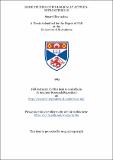Files in this item
Some studies of biologically active S-nitrosothiols
Item metadata
| dc.contributor.advisor | Buter, Anthony (Anthony R.) | |
| dc.contributor.advisor | Flitney, Eric | |
| dc.contributor.author | Askew, Stuart Clive | |
| dc.coverage.spatial | 236 p. | en_US |
| dc.date.accessioned | 2018-07-10T13:51:25Z | |
| dc.date.available | 2018-07-10T13:51:25Z | |
| dc.date.issued | 1995 | |
| dc.identifier.uri | https://hdl.handle.net/10023/15189 | |
| dc.description.abstract | S-nitrosothiols are effective NO-donating drugs which can elicit vasodilation of vascular tissue and disaggregate or inhibit the aggregation of platelets in blood. The chemistries of two S-nitrosothiols, S-nitroso-N-acetyl-DL-penicillamine (SNAP) and S-nitrosoglutathione (GSNO) have been investigated in an attempt to identify the chemical and physiological mechanisms which underlie their biological actions as vasodilators and modulators of platelet behaviour. Although SNAP and GSNO have been found to be susceptible to decomposition by similar chemical mechanisms, such as by thermal and photochemical means, evidence is presented to suggest that they are both capable of NO transfer to other thiol containing compounds such as cysteine. This produces a very unstable S-nitrosothiol, S-nitrosocysteine, which readily produces NO. However, they can both be decomposed by different, distinctive mechanisms. Metal ion catalysis by copper is shown to greatly accelerate the decomposition of SNAP, but has little effect on GSNO. Instead, NO release from GSNO is effected by enzymatic cleavage of the glutamyl-cysteinyl peptide bond by the enzyme glutamyl transpeptidase (γ-GT). The resulting S-nitrosothiol, S-nitrosocysteinylglycine, would be expected to be more susceptible to release of NO by metal (copper) ion catalysis. It is concluded that transnitrosation (NO-transfer) between thiol groups, or enzymatic cleavage are obligatory steps in the mechanism of NO release from GSNO, whereas SNAP requires only the presence of trace amounts of metal ions like copper to effect this process. The different modes of NO production may go some way towards explaining the different physiological effectiveness of these S-nitrosothiols as vasodilators and inhibitors of platelet aggregation. | en_US |
| dc.language.iso | en | en_US |
| dc.publisher | University of St Andrews | |
| dc.subject.lcc | QD341.N8A8 | |
| dc.subject.lcsh | Nitro compounds | en |
| dc.title | Some studies of biologically active S-nitrosothiols | en_US |
| dc.type | Thesis | en_US |
| dc.contributor.sponsor | British Heart Foundation | en_US |
| dc.type.qualificationlevel | Doctoral | en_US |
| dc.type.qualificationname | PhD Doctor of Philosophy | en_US |
| dc.publisher.institution | The University of St Andrews | en_US |
This item appears in the following Collection(s)
Items in the St Andrews Research Repository are protected by copyright, with all rights reserved, unless otherwise indicated.

